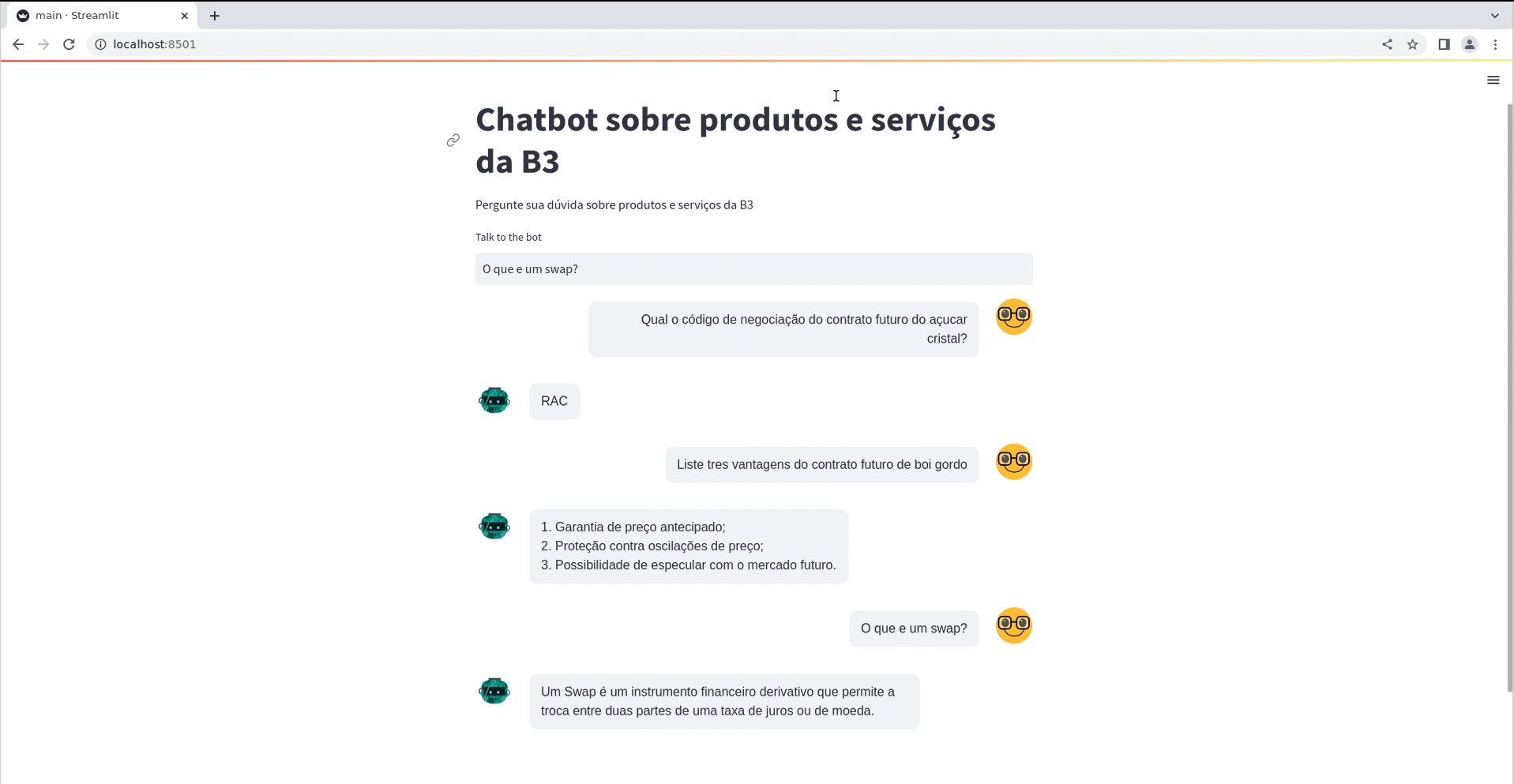==============================
This is a project to create a QA chatbot to answer questions about B3 products and services.
Ubuntu/Debian/Mint
The GNU/Linux Make utility is required to run the Makefile. To install it, run the following command:
sudo apt-get install build-essentialAlso, the Python 3 interpreter is required to run the project. To install it, run the following command:
sudo apt-get install python3To set up the environment, run the following command:
python3 -m venv ~/path/to/venvTo activate the environment, run the following command:
source ~/path/to/venv/bin/activateTo install the dependencies, run the following command:
make requirementsFor this project, we will use the OpenAI API to generate responses for the chatbot. To configure the API, you need to create an account in OpenAI. After that, you need to create an API key in the dashboard. Finally, you need to add the API key to conf/parameters.yaml in the api_key field.
In this project, we use Makefile to run the project steps. To run the project, run the following commands:
make download_urlsThis command will download the urls from the urls of products and services from B3 website.
make download_docsThis command will download the text documents from the urls downloaded in the previous step.
make cleaning_docsThis command will clean the text documents downloaded in the previous step.
make write_docsThis command will write the text documents in a Elasticsearch database
make qa_modelThis command will generate the QA pipeline and save in a yaml file
├── LICENSE <- Repository license
├── Makefile <- Makefile with commands like `make write_docs` or `make qa_model`
├── README.md <- The top-level README for developers using this project.
├── app <- App folder with the API and the web app
│ ├── backend <- Backend folder with the API and the data expecting for the api
│ │ └── api.py <- API with the endpoints to predict and train the model
│ └── frontend <- Frontend folder with the web app
│ └── main.py <- Web app with the interface to predict and train the model
├── conf <- Configuration folder with the parameters used by the project
│ ├── catalog.yaml <- Catalog file with the paths to the data
│ ├── parameters.yaml <- Parameters file with the parameters used by the project
│ └── pipeline.yaml <- Pipeline file with the pipeline used by the project
├── configs.ini <- Config file with the parameters to be used by the API
├── data <- Data folder with the data used by the project
│ ├── 01_raw <- Raw data folder
│ ├── 02_intermediate <- Intermediate data folder
│ └── 03_features <- Features data folder
├── notebooks <- Jupyter notebooks used to experiment and develop the project
├── requirements-dev.in <- The file where you should put the development dependencies like Black, Pytest, etc.
├── requirements-dev.txt <- ❗This file will be automatically generated by the pip-compile, DON'T EDIT IT❗
├── requirements.in <- The file where you should put the modules and scripts dependencies.
├── requirements.txt <- ❗This file will be automatically generated by the pip-compile, DON'T EDIT IT❗
├── src <- Source code for use in this project.
│ └── pipelines <- Pipeline folder with the pipeline used by the project
│ ├── etl <- ETL pipeline folder with the scripts used by the pipeline
│ │ ├── cleaning_docs.py <- Script to clean the text documents
│ │ ├── download_docs.py <- Script to download the text documents
│ │ ├── download_urls.py <- Script to download the urls from the B3 website
│ │ ├── prepare_data.py <- Script to prepare the data to be used by the API
│ │ ├── scrap_data.py <- Script to scrap the data from the B3 website
│ │ └── write_docs.py <- Script to write the text documents in a Elasticsearch database
│ └── qa <- QA pipeline folder with the scripts used by the pipeline
│ └── qa_model.py <- Script to generate the QA pipeline and save in a yaml file
└── tox.ini <- tox file with settings for running tox; see tox.testrun.org
To test the model with the API, run the following command:
uvicorn app.backend.api:app --reloadAfter that you can open in another terminal the UI to test the API with the following command:
streamlit run app/frontend/main.py - Add logs
- Add tests
- Add CI/CD
- Add Dockerfile
- Add Docker Compose
- Add orchestration with Prefect
- Refactor the code

